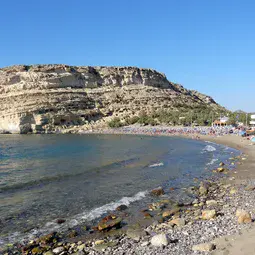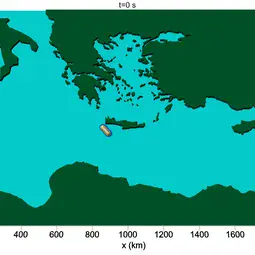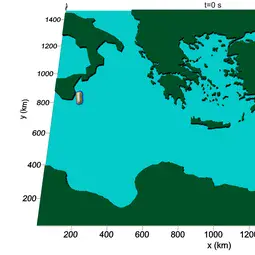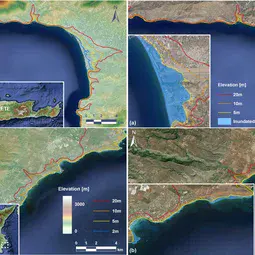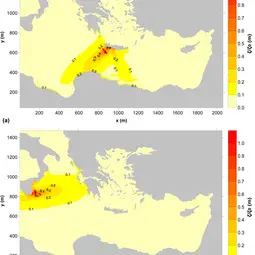What would a tsunami in the Mediterranean look like?
A team of European researchers have developed a model to simulate the impact of tsunamis generated by earthquakes and applied it to the Eastern Mediterranean. The results show how tsunami waves could hit and inundate coastal areas in southern Italy and Greece. The study is published today (27 August) in Ocean Science, an open access journal of the European Geosciences Union (EGU).
Though not as frequent as in the Pacific and Indian oceans, tsunamis also occur in the Mediterranean, mainly due to earthquakes generated when the African plate slides underneath the Eurasian plate. About 10% of all tsunamis worldwide happen in the Mediterranean, with on average, one large tsunami happening in the region once a century. The risk to coastal areas is high because of the high population density in the area – some 130 million people live along the sea’s coastline. Moreover, tsunami waves in the Mediterranean need to travel only a very short distance before hitting the coast, reaching it with little advance warning. The new study shows the extent of flooding in selected areas along the coasts of southern Italy and Greece, if hit by large tsunamis in the region, and could help local authorities identify vulnerable areas.
“The main gap in relevant knowledge in tsunami modelling is what happens when tsunami waves approach the nearshore and run inland,” says Achilleas Samaras, the lead author of the study and a researcher at the University of Bologna in Italy. The nearshore is the zone where waves transform – becoming steeper and changing their propagation direction – as they propagate over shallow water close to the shore. “We wanted to find out how coastal areas would be affected by tsunamis in a region that is not only the most active in the Mediterranean in terms of seismicity and tectonic movements, but has also experienced numerous tsunami events in the past.”
The team developed a computer model to represent how tsunamis in the Mediterranean could form, propagate and hit the coast, using information about the seafloor depth, shoreline and topography. “We simulate tsunami generation by introducing earthquake-generated displacements at either the sea bed or the surface,” explains Samaras. “The model then simulates how these disturbances – the tsunami waves – propagate and are transformed as they reach the nearshore and inundate coastal areas.”
As detailed in the Ocean Science study, the team applied their model to tsunamis generated by earthquakes of approximately M7.0 magnitude off the coasts of eastern Sicily and southern Crete. Results show that, in both cases, the tsunamis would inundate the low-lying coastal areas up to approximately 5 metres above sea level. The effects would be more severe for Crete where some 3.5 square kilometres of land would be under water.
“Due to the complexity of the studied phenomena, one should not arbitrarily extend the validity of the presented results by assuming that a tsunami with a magnitude at generation five times larger, for example, would result in an inundation area five times larger,” cautions Samaras. “It is reasonable, however, to consider such results as indicative of how different areas in each region would be affected by larger events.”
“Although the simulated earthquake-induced tsunamis are not small, there has been a recorded history of significantly larger events, in terms of earthquake magnitude and mainshock areas, taking place in the region,” says Samaras. For example, a clustering of earthquakes, the largest with magnitude between 8.0 and 8.5, hit off the coast of Crete in 365 AD. The resulting tsunami destroyed ancient cities in Greece, Italy and Egypt, killing some 5000 people in Alexandria alone. More recently, an earthquake of magnitude of about 7.0 hit the Messina region in Italy in 1908, causing a tsunami that killed thousands, with observed waves locally exceeding 10 metres in height.
The team sees the results as a starting point for a more detailed assessment of coastal flooding risk and mitigation along the coasts of the Eastern Mediterranean. “Our simulations could be used to help public authorities and policy makers create a comprehensive database of tsunami scenarios in the Mediterranean, identify vulnerable coastal regions for each scenario, and properly plan their defence.”
###
Please mention the name of the publication (Ocean Science) if reporting on this story and, if reporting online, include a link to the paper (http://www.ocean-sci.net/11/643/2015/os-11-643-2015.html) or to the journal website (http://www.ocean-science.net).
More information
This research is presented in the paper ‘Simulation of tsunami generation, propagation and coastal inundation in the Eastern Mediterranean’ published in the EGU open access journal Ocean Science on 27 August 2015.
Citation: Samaras, A. G., Karambas, Th. V., and Archetti, R.: Simulation of tsunami generation, propagation and coastal inundation in the Eastern Mediterranean, Ocean Sci., 11, 643-655, doi:10.5194/os-11-643-2015, 2015.
The team is composed of A. G. Samaras (Interdepartmental Centre for Industrial Research in Building and Construction [CIRI-EC], Fluid Dynamics Unit, University of Bologna, Italy), Th. V. Karambas (Department of Civil Engineering, Aristotle University of Thessaloniki, Greece) and R. Archetti (Department of Civil, Chemical, Environmental and Materials Engineering, University of Bologna, Italy).
The European Geosciences Union (EGU) is Europe’s premier geosciences union, dedicated to the pursuit of excellence in the Earth, planetary, and space sciences for the benefit of humanity, worldwide.It is a non-profit interdisciplinary learned association of scientists founded in 2002. The EGU has a current portfolio of 17 diverse scientific journals, which use an innovative open access format, and organises a number of topical meetings, and education and outreach activities. Its annual General Assembly is the largest and most prominent European geosciences event, attracting over 11,000 scientists from all over the world. The meeting’s sessions cover a wide range of topics, including volcanology, planetary exploration, the Earth’s internal structure and atmosphere, climate, energy, and resources. The EGU 2016 General Assembly is taking place in Vienna, Austria, from 17 to 22 April 2016. For information about meeting and press registration, please check http://media.egu.eu closer to the time of the conference, or follow the EGU on Twitter and Facebook.
If you wish to receive our press releases via email, please use the Press Release Subscription Form at http://www.egu.eu/news/subscribe/. Subscribed journalists and other members of the media receive EGU press releases under embargo (if applicable) 24 hours in advance of public dissemination.
Ocean Science (OS) is an international open-access scientific journal dedicated to the publication and discussion of research articles, short communications, and review papers on all aspects of ocean science: experimental, theoretical, and laboratory. The primary objective is to publish a very high-quality scientific journal with free Internet-based access for researchers and other interested people throughout the world.
Contact
Achilleas Samaras
Research Fellow
University of Bologna, Italy
Phone +39-05120-90551
Email achilleas.samaras@unibo.it
Skype: achilleas.samaras
Bárbara Ferreira
EGU Media and Communications Manager
Munich, Germany
Phone +49-89-2180-6703
Email media@egu.eu
EGU on Twitter: @EuroGeosciences
Links
- Scientific paper
- Journal – Ocean Science
- Read this press release in simplified language, aimed at 7–13 year olds, on our Planet Press site


